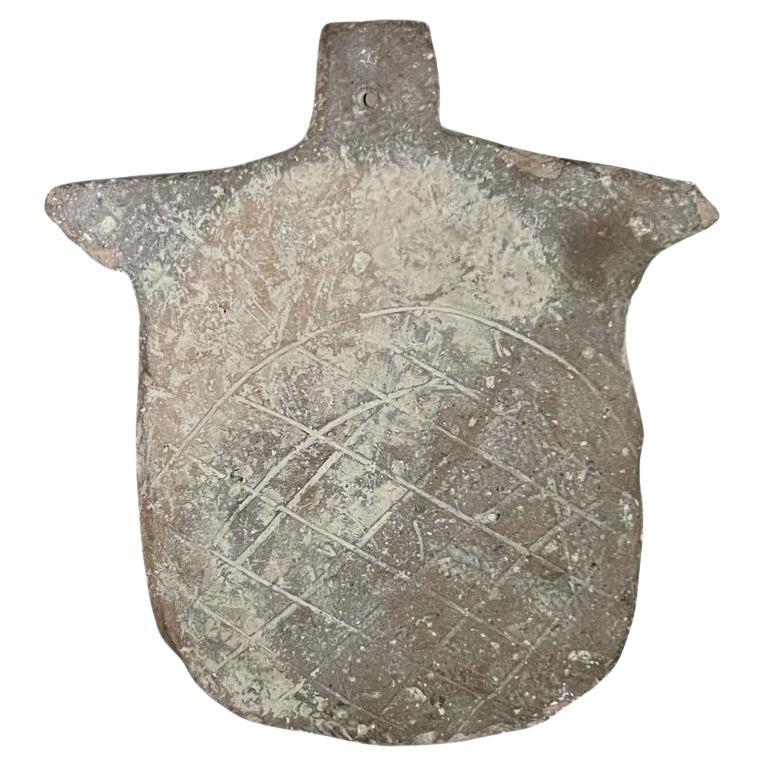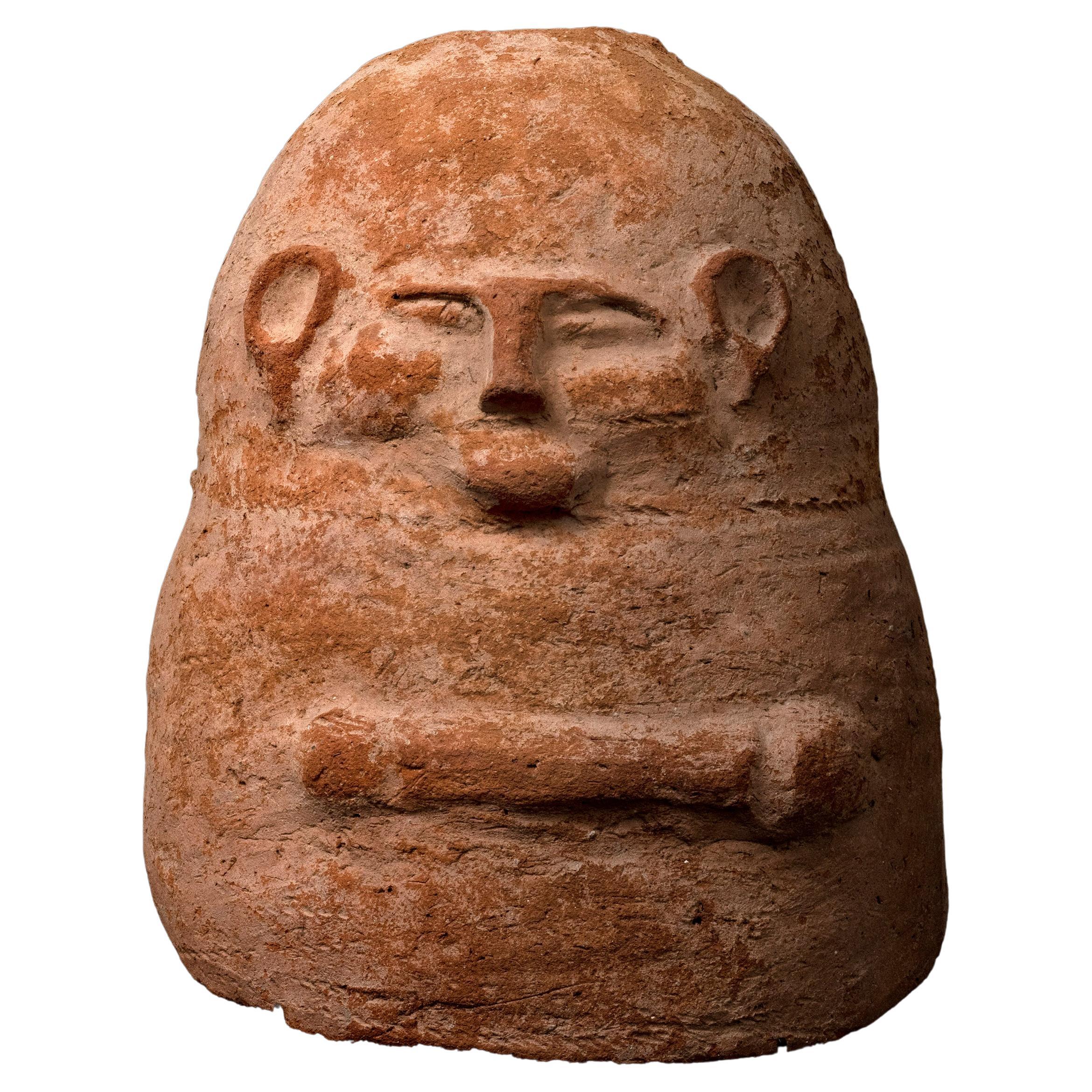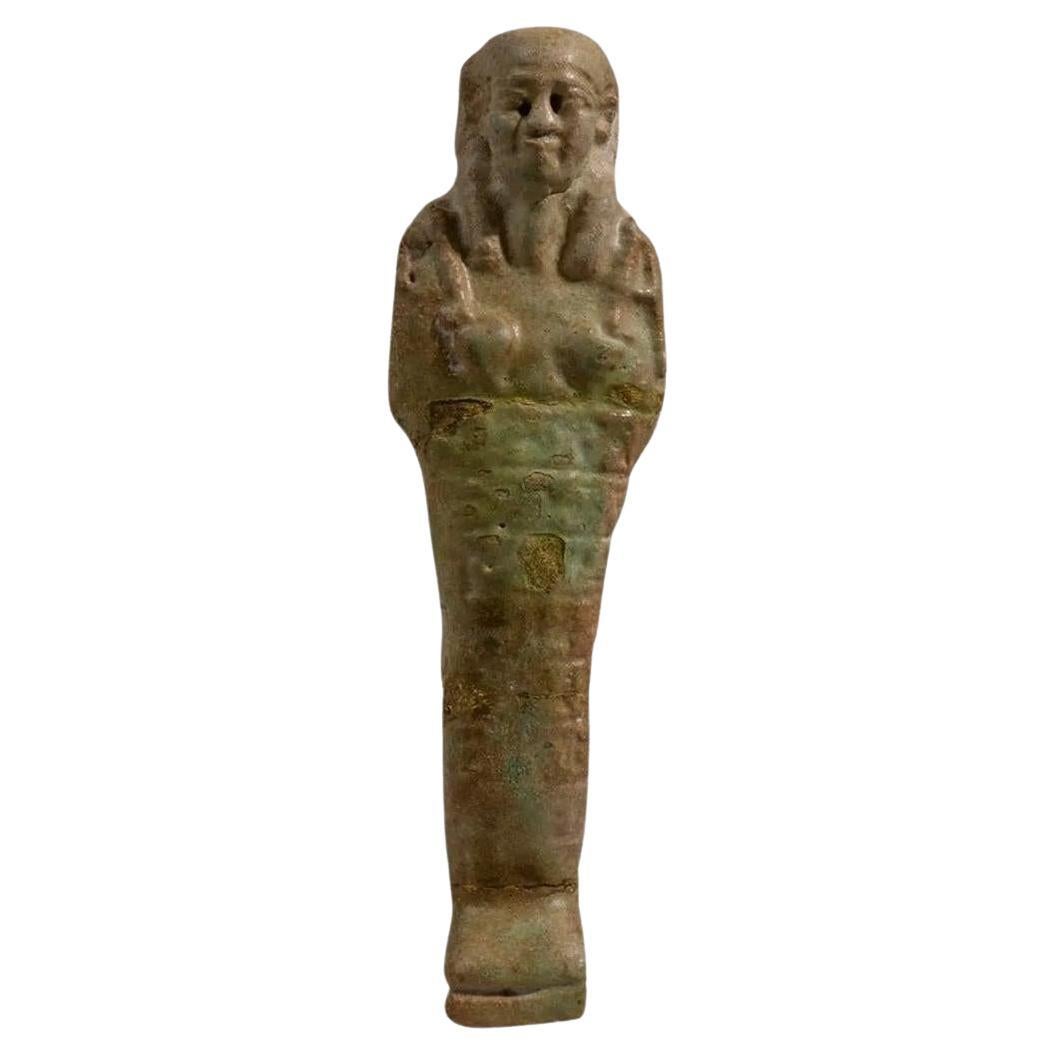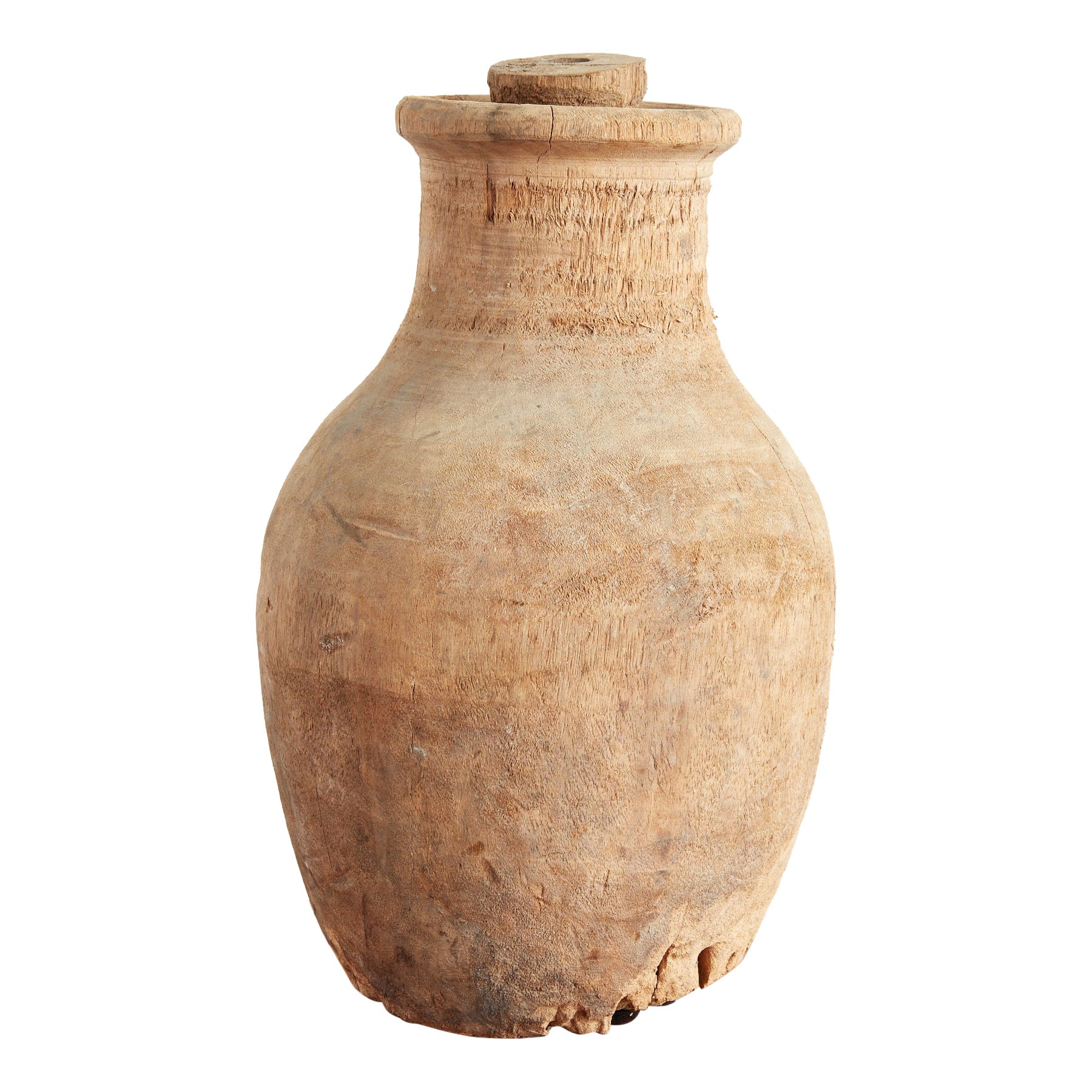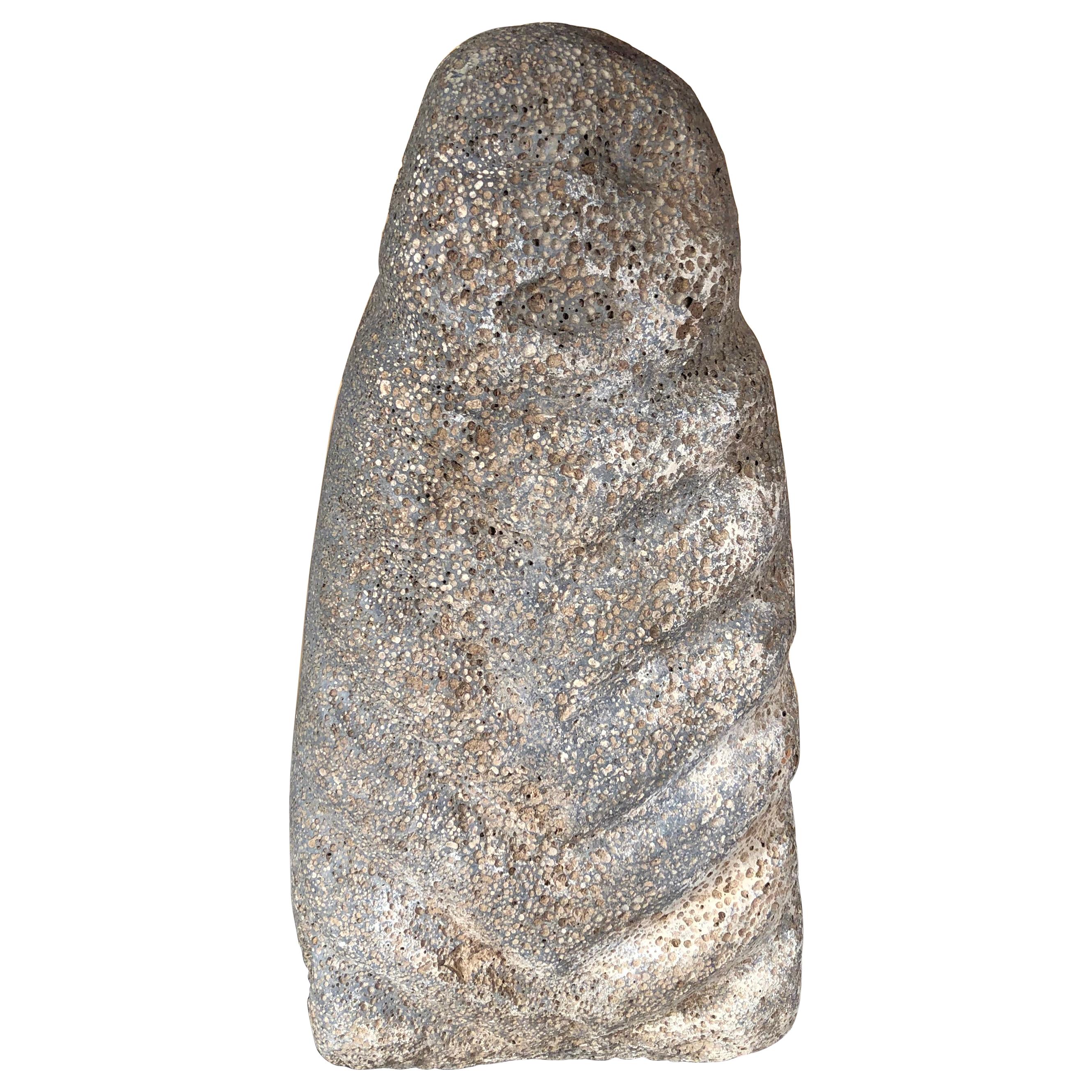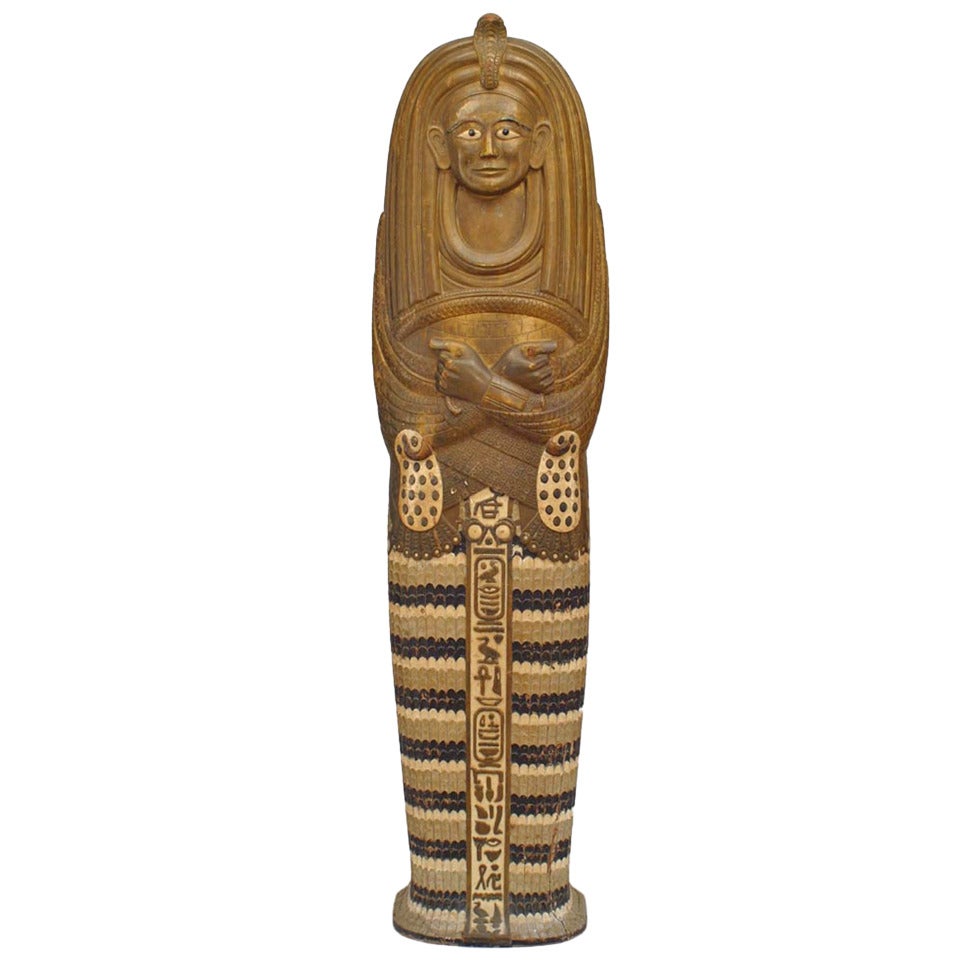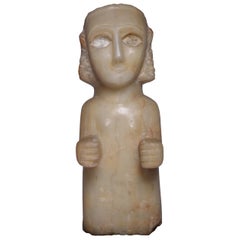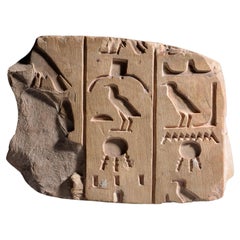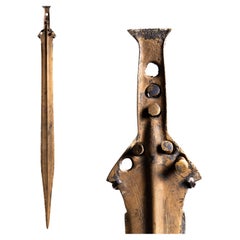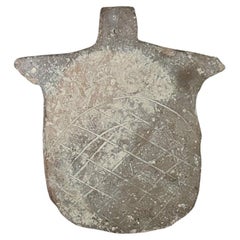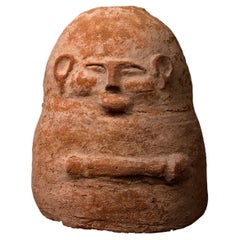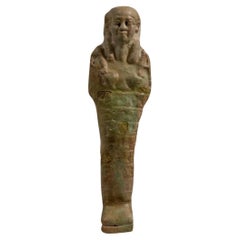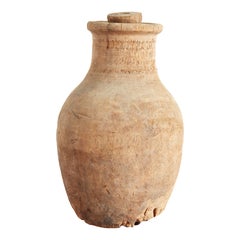Items Similar to Bronze Age Cypriot Plank Idol
Want more images or videos?
Request additional images or videos from the seller
1 of 7
Bronze Age Cypriot Plank Idol
$150,000
£111,367.02
€129,773.22
CA$208,248.45
A$232,938.98
CHF 121,222.82
MX$2,867,558.28
NOK 1,542,205.42
SEK 1,446,892.70
DKK 968,237.70
Shipping
Retrieving quote...The 1stDibs Promise:
Authenticity Guarantee,
Money-Back Guarantee,
24-Hour Cancellation
About the Item
Cypriot Plank Idol
Early Bronze Age III - Middle Bronze Age I, c. 2100 - 1850 BC.
Low fired burnished earthenware pottery with lime-filled incisions
A Cypriot plank idol, an iconic form of human representation from Bronze Age Cyprus.
A highly stylised figurine, with a flat rectangular body and narrower head and neck, featuring incised lime-filled decoration across the top half of the body, and two incised lines dropping down from the shoulders. The nose depicted in relief, with incised eyes, eye- brows, nostrils and mouth. Waved line incisions on the edge of the head perhaps indicating hair.
Identified today with the elusive kingdom of Alashiya, Bronze Age Cyprus was an island of unique and distinctive culture. At the beginning of this period (c.2500 BC), migrants from Anatolia introduced the Philia Culture to the northern coast of Cyprus, establishing a new era in the island’s prehistory. Marking the end of the Chalcolithic period, innovative types of pottery were produced, and inhabitants began to experiment with new technologies of bronze metal production.1 In particular, the exploitation of copper resources in the Troodos foothills provided the foundation for acquiring and displaying wealth.2 In high demand throughout the Mediterranean world, Cypriots now exported large quantities of this raw material in exchange for luxury goods such as silver and gold, ivory, perfumed oils, and precious furniture.3 Through such trade, Cyprus established connections with Minoan Crete and Mycenaean Greece, as well as the ancient civilisations of Egypt and the Near East.4 Imported goods from these kingdoms were, in turn, used as status symbols. Over this period, the number and siz- es of settlements also increased, suggesting that this prosperity was underpinned by a rise in population.
The middle Bronze Age also marked an expansion in artistic production, typified by the proliferation of new types of pottery, including Black Slip ware, Red-on-Black ware and white painted ware. Moreover, potters now produced large ‘scenic vessels’ which depicted the everyday activities of the island’s inhabitants, providing invaluable evidence to archaeologists and anthropologists today. The cultural affluence of this period also resulted in huge quantities of grave-goods to accompany a person to the afterlife. The deposition of metal goods in particular reached remarkable heights during this period, and for the first time, tombs included items such as tools and weapons, as well as new types of pottery, and imported jewellery such as gold rings, diadems and faience necklaces. Such evidence has been particularly well documented during the three major excavations at Lapithos. Plank idols are also a common feature of these richly ornamented graves. Tombs themselves were now used for several generations, suggesting that greater emphasis was beginning to be placed on group or family identity. Indeed, this was a time of significant political and economic change, and the emergence of new social structures resulted in lavishly decorated tombs, fulfilling the emerging desire to visually confirm one’s social status, both in life and in death.
Forms of human representation by the artists of ancient Cyprus are easily identifiable to the period they come from. For the early and middle Bronze Age, the traditional form of human representation was the plank idol or figurine. These often simplified forms are highly stylised, with a flat rectangular body, and narrowed head and neck. Facial features and ornaments are indicated by incised and painted patterns, with the exception of the nose and ears (and occasionally breasts) which are modelled in relief. In some cases, they also have two heads, or three necks, or they even depict a mother holding a child. As highly expressive objects, with a significant aesthetic quality, it is clear they were made by skilled potters and designed for visual impact and display. Generally found in graves, their archeological context has led to the belief in their religious and symbolic significance.
When Cypriot plank idols were first discovered in 1913, they were tentatively identified as female. This was the result of their elaborate incised decoration and jewellery, as well as the discovery of some depicted with breasts modelled in relief. Just as large vessels from this period depict scenes from everyday life, it was thought that these figurines may have depicted women in their various roles, for example, as mothers or officiating at the sanctuary in full ceremonial dress. However, the significant absence of male figurines in a presumably patriarchal society led scholars to identify them with the fertility cult of the ‘Great Mother Goddess’. It has been noted that per- haps those idols with two heads or three necks may have been significant in asking for twins, triplets or a larger family. Given that these female figurines are frequently found in graves, it has also been suggested that the fertility goddess was a symbol of rebirth or regeneration.
However, more recently, the identification of plank idols with the Great Mother Goddess has been questioned, on account of the considerable number of figurines that bear no identifying features of the female sex. Instead, their appearance at a time of significant political, hierarchical and economic change, as well as their archaeological contexts has led to the belief that that plank ‘idols’ were in fact figurines designed as a conspicuous symbol of social prestige, and a marker of group identity with particular reference to ancestral authority.
Whether idol or ancestor, these figurines emerge from a crucial time in Cypriot early history, and their aesthetic nature means that they have been highly sought after by the modern collector.
Provenance:
Collection de Mme S.; Objets de Haute Curiosité et d’Archéologie, Hôtel Drouot, Paris, 2nd June 1967, Lot 99.
Mr and Mrs Jacques and Françoise Martinet collection, acquired at the above sale Thence by descent.
- Dimensions:Height: 9 in (22.86 cm)Width: 3 in (7.62 cm)Depth: 0.25 in (6.35 mm)
- Materials and Techniques:
- Place of Origin:
- Period:
- Date of Manufacture:Bronze Age, circa 2100 - 1850 BC
- Condition:Repaired. Wear consistent with age and use.
- Seller Location:London, GB
- Reference Number:Seller: 431941stDibs: LU1052238096252
About the Seller
5.0
Recognized Seller
These prestigious sellers are industry leaders and represent the highest echelon for item quality and design.
Established in 2007
1stDibs seller since 2014
101 sales on 1stDibs
Typical response time: 1 hour
Associations
LAPADA - The Association of Arts & Antiques DealersInternational Confederation of Art and Antique Dealers' AssociationsThe British Antique Dealers' Association
- ShippingRetrieving quote...Shipping from: London, United Kingdom
- Return Policy
Authenticity Guarantee
In the unlikely event there’s an issue with an item’s authenticity, contact us within 1 year for a full refund. DetailsMoney-Back Guarantee
If your item is not as described, is damaged in transit, or does not arrive, contact us within 7 days for a full refund. Details24-Hour Cancellation
You have a 24-hour grace period in which to reconsider your purchase, with no questions asked.Vetted Professional Sellers
Our world-class sellers must adhere to strict standards for service and quality, maintaining the integrity of our listings.Price-Match Guarantee
If you find that a seller listed the same item for a lower price elsewhere, we’ll match it.Trusted Global Delivery
Our best-in-class carrier network provides specialized shipping options worldwide, including custom delivery.More From This Seller
View AllAncient South Arabian Alabaster Statue
Located in London, GB
South Arabian Calcite female figure
3rd Century BC to 1st century A.D.
Calcite Alabaster
height: 30.5 cm
A magnificent alabaster female figure, a f...
Category
Antique 15th Century and Earlier Yemeni Figurative Sculptures
Materials
Alabaster
Ancient Egyptian Limestone Relief with Hieroglyphs
Located in London, GB
Egyptian New Kingdom Relief Fragment
Carved limestone
New Kingdom, circa 1550-1069 BC
12 x 16.5 cm
This beautiful fragment preserves three columns of neat hieroglyphs deeply carved ...
Category
Antique 15th Century and Earlier Egyptian Mounted Objects
Materials
Limestone
Late Bronze Age Sword
Located in London, GB
Saint Nazaire Sword, Late Bronze Age, circa 800-900 B.C.
An exceptionally well preserved Bronze Age sword, with elegant, finely incised decorations,...
Category
Antique 15th Century and Earlier French Abstract Sculptures
Materials
Bronze
Ancient Greek Perfume Bottle
Located in London, GB
Athenian Black-glaze perfume pot with inscription
Athens, c. 425-400 B.C.
Terracotta
Measures: Height: 9cm; diameter across lip: 7.5cm; width including handle: 9cm
This 5th Cen...
Category
Antique 15th Century and Earlier Italian Classical Greek Bottles
Materials
Pottery
Ancient Egyptian Painted Relief Carving of a Man and his Wife
Located in London, GB
A superb raised relief, carved in fine native limestone during a golden era of cultural and artistic flourishing in ancient Egypt. The scene portrays a high-ranking official, elegant...
Category
Antique 15th Century and Earlier Mounted Objects
Materials
Limestone
Monolithic Stone Meteorite
Located in London, GB
Unclassified Meteorite
Stone
Height: 36.83 cm
42.5 kg
A dramatic extraterrestrial sculpture, of monolithic form, covered in a thick grey-brown fusion crust and with areas of sandy deposits from untold years spent on the desert floor. Formed in the asteroid belt between Mars and Jupiter during the formation of our solar system, some 4.55 billion years ago, this large stone would have been separated from its parent body by an enormous impact before journeying through interplanetary space and eventually reaching Earth.
Upon atmospheric entry it would have reached cosmic velocity, heating the surrounding air to 1700°C and producing a large ball of fire. The heat was sufficient to melt the outer surface of the stone, exposing a new surface which in turn also melted away, losing as much as 95% of its initial mass before reaching the ground. The last molten layer to form as it collided with the Earth covered the stone in a layer of fusion crust, evidence of the incredible impact force delivered by this extraordinary specimen.
“This unclassified stone meteorite was found in Northwest Africa. It has a relatively smooth, dark brown, slightly weathered fusion crust; some small melt veins are visible on the surface. Due to the near-absence of terrestrial rocks in this region of the Sahara, meteorite hunting in this area has yielded many notable discoveries.”
Dr Alan E. Rubin, PhD Department of Earth, Planetary, and Space Sciences...
Category
Antique 15th Century and Earlier North African Natural Specimens
Materials
Stone
You May Also Like
Anatolian Ceramic Idol, Early Bronze Age circa 2700-2400 BCE
Located in Vosselaar, BE
A interesting example of a kusura type bronze age idol. These are usually found in marble but this one is in ceramic. These idols represent a stylized female shape and represent fert...
Category
Antique 15th Century and Earlier Turkish Archaistic Antiquities
Materials
Ceramic
Canaanite Anthropoid Coffin Lid - 12th-10th century BC
Located in Bruxelles, BE
Rare Canaanite Anthropoid Coffin Lid
Terra Cotta
12th – 10th Century BC
Provenance:
Public Auction Paris (2022)
Private Collection F. Antonovich (Paris – 1980s)
Art Loss Register...
Category
Antique 15th Century and Earlier Israeli Archaistic Wall-mounted Sculptures
Materials
Terracotta
Ancient Egyptian Faience Ushabti Figure, c. 700-30 B.C.
Located in Los Angeles, CA
An impressive Ancient Egyptian Faience Ushabti figure, belonging to the c. 700-30 B.C. It consists of a molded pottery having a green glazed surface. The figure is wearing a royal wi...
Category
Antique 15th Century and Earlier Egyptian Figurative Sculptures
Materials
Pottery
Primitive Wood Mold
Located in Beverly Hills, CA
Primitive wood mold with fantastic patina
Different shapes available - priced separately but wonderful as a collection
France circa 1940s.
Category
Vintage 1940s French Abstract Sculptures
Materials
Wood
$1,500
Chinese Ancient Hongshan Culture Stone Sculpture, 4700-2900 BC
Located in South Burlington, VT
China, a fine archaic human effigy hand-carved from a granular medium to dark gray volcanic stone with six (6) "V" sections carved front. Neolithic period, Hongshan culture...
Category
Antique 15th Century and Earlier Chinese Antiquities
Materials
Stone
Egyptian Carved Sarcophagus Figure
Located in Queens, NY
Egyptian carved and painted life size sarcophagus figure (19/20th Cent)
Category
Antique 19th Century Unknown Egyptian Sculptures
Materials
Wood, Paint
More Ways To Browse
Cyprus Furniture
Paris Ware
Egyptian Ornament
Pottery Bc
Antique Egyptian Ring
Sex Jewelry
Antique Religious Ring
Antique Metal Figurines
Maling Pottery
Antique Mothers Ring
Bc Antiques
Antique Diadem
Greek Religious Icons
Antique Crete
Ancient Greek Dress
Red And Gold Perfume
Ancient Rings Bc
Bronze Breast Sculpture
